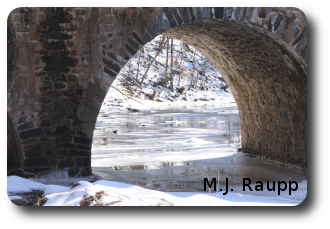This week’s remarkable meteorological contrasts started with a wicked winter storm that brought snow and bone-chilling temperatures to the eastern United States and ended with temperatures in the 60s and 70s throughout much of the region. Along the banks of snowy creeks, romance was in the air or more precisely on the ice and snow where hopeful male stoneflies did their best to attract the attention of the ladies. These rather ancient insects can be found on stones, vegetation, and bridges near streams from January through March when most of their six-legged kin are nowhere to be seen in a resting state called diapause. Adult winter stoneflies are dark brown or black and are active day and night. In their youth, stoneflies live the life aquatic. Juvenile winter stoneflies, called nymphs, graze on submerged aquatic vegetation or decaying organic matter.
Stonefly nymphs search for food and hide among the small stones at the bottom of streams.
Many species of stoneflies have abandoned the vegan lifestyle and eat aquatic insects including other stoneflies. Stonefly nymphs obtain oxygen from the water through delicate gills lining the neck, thorax, or abdomen. Most immature insects shed their skin or molt just a few times as they develop. However, some species of stoneflies molt more than 20 times before leaving the water to become adults. When the nymph has completed development, it moves to the edge of the stream, emerges from the water, and latches onto a stone or plant. The skin of the nymph splits and the adult stonefly wiggles itself free. The diet of adult stoneflies varies according to species. Some eat lichens, algae, or vegetation, but others gain all the nutrients needed as nymphs and never feed as adults. Winter stoneflies are relatively weak fliers and seem to prefer walking and running to flying. However, other species of stoneflies are good fliers and are attracted to porch lights or bug zappers.
Clean, fast-moving streams and rivers are excellent places to observe winter stoneflies.
Stonefly courtship is a curious matter in some species. A hopeful male uses his abdomen to “drum” the surface of a resting place such as a small branch to create a specific beat. If a female of the same species is nearby and favorably impressed by his rhythm and sound, she will drum a reply with her abdomen. The percussive duet continues and if both like what they sense, the deal is sealed and they mate. After mating, the female stonefly will swoop to the surface of the water to deposit her eggs. This is a time of joy for fish below in the water. Trout, steelhead, and other freshwater fish find stonefly nymphs and adults delectable. Both adult and juvenile stoneflies are an important source of food for denizens of our streams. Fisherman have taken advantage of this passion and created a variety of lures that mimic stoneflies with colorful names like Montana Stone Yellow and Henry's Fork Yellow Sally. Stoneflies are also important indicators of water quality. Streams with heavy sediments, low oxygen content, or pollutants do not support a diversity or abundance of stoneflies. Stoneflies emerging from your local stream are a positive sign of a healthy environment. So, during the next few weeks take a walk on a sunny afternoon and visit a small stream or river to seek the stonefly. The best viewing is had when stream banks are covered with snow and stoneflies clamber from the chilly waters.
References:
The fascinating book “Aquatic Entomology” by W. Patrick McCafferty was used as a reference for this Bug of the Week. To learn more about stoneflies, please visit the following web sites.


